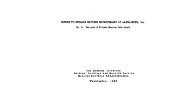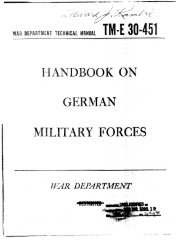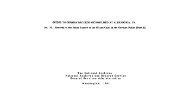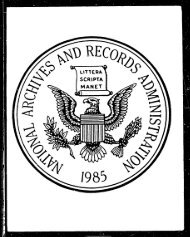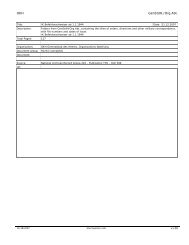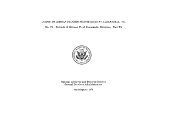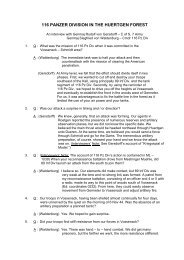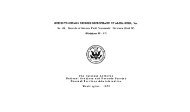Some indication of the type of German personnel employed inthe Frontftthrung in the Yfest, shortly before the Allied liberationof this territory, is reflected in an arrangement which Wehrmachtauthorities concluded with the OT in July 192*4. By this arrangement500 OT men born after 1899 ani classified as fit for <strong>com</strong>batduty were exchanged for 2500 incapacitated officers and enlistedmen, for assignments under the various OBL Frontftthrungen.In the matter of discipline and counter-intelligence, thesphere of the Frontf ahrer overlaps with that of the SS Verbindungsftthrer(SS-OT Liaison Officer). The basic cause for frictionbetween the two - when friction does develop - is usually shortageof manpower, differences arising over <strong>com</strong>petence in the reooveryof deserters and in dealing with individual irregularities. TheProntfahrer will often overlook infractions of discipline, whilethe SS Liaison Officer will insist on punishment in dealing withthe same case. Much depends, in this respect, on the personalitiesof the Frontfubrer and the Verbindungsfuhrer and on whether or notthe former is an SS, SA or active NSDAP man.At the present time, however, most, if not all, Frontfuhrermay be presuaed to be SS men.127. Referat Technik (Technical Section).The technical section in an QBL HQ, which deals with alltechnical and engineering problems, is subdivided into a numberof sub-sections, the functions of which are given in Charts 6aand 6b.ii)Administrative Personnel above OBL level.128. Einsatz, Einsatzgruppe and Amt Bau-QTZ (Area Control Staff,Army Level; Area Control Staff, Army Group Level; Bureau"*"Construction OT Central HQ).An important function of theOT control staff on Einsatzlevel, is that of OT liaison with military and civilian authoritieson regional level. Consequently, the Einsatz HQ is staffed withconstruction officials dealing with OT activities on three differentlevels: (1) controlling the construction programme of subordinateOberbauleitungen; (2) acting as liaison between theOT and theArmament Commission and the Reich Defence Commissioner; (3) sendingreports of estimated requirements in materials and manpower tohigher level (Einsatzgruppe), on the basis of previous consultationswith the military and civilian authorities mentioned in (2).Por fuller discussion, see IIAb35, IIGa86 and IIGa96v, also Chart5cThe OT control staff on Einsatzgruppe level distributesallotments of materials and manpower to its subordinate QBL 1 s onthe following basis: firstly according to the general directivesfrom Amt Bau-OTZ, secondly according to the large scaleoperational requirements of the German Army, Navy and Air Force,thirdly according to strategic requirements (e.g. repair ofarmament factories), and fourthly, according to vital civilianrequirements. Estimates of requirements in the last two casesmentioned are based on reports sent in by the subordinate Einsatzstaffs; estimates of large scale operational requirements arebased on consultation (on EG level) with Hauptbectarsffcrftger(Principal Consumers: Army, Navy, Air Force, the SS and so forth).Por fuller discussion see IlAb34, IIGa86, and Charts 5a and 5b.The Bureau: Construction - OT CentralHQ (last known address,BERLIN in the SHEER Ministry has been fully discussed in IlAb32.Known personalities in key positions on its staff are given inCharts 4a and Ifr.
C; Training.129. Military Training.Regulations issued by the Wehraaoht tiirou^i the OT, providedfor basic military training of all German personnel (both Reichand "racial" Germans) and for "reliable" elements of foreignpersonnel. In actual practice, however, these regulations werecarried out spasmodically at best. In theory the trainingprocedure was as follows: a German employee of an OT-Firm wasupon enrolment in the OT issued a uniform and given militarytraining. The latter consisted of rifle drill and practice, and acertain amount of <strong>com</strong>bat training. It was carried out underWehrmacht supervision and usually took place on Sundays or afterwork, alttou#i sometimes a group of workers was taken from theirjobs to partake in these military exercises. In case of invasion,these men were to assist the Armed Forces.When in January 1944, the danger of an invasion seemed to havebe<strong>com</strong>e more imminent, the Frontfflhrung West (EGW), issued an orderthat every firm should form a training and <strong>com</strong>bat unit of its own.This regulation obviated the necessity for constant Wehrmachtassistance in this respect. These units were armed, mostly withcaptured weapons of various makes, but an attempt was made atuniformity by restricting the equipment of each firm to one type ofrifle. For every German, the official issue was one rifle and 198rounds of ammunition. Thirty rounds were to be carried on the constructionsite, the remaining ammunition was to be stored in aplace easily accessible in case of alarm. Pistols were only issuedta OT officers and to NCOs. from the rank of Obermeister up. Itwas laid down that, in case of alarm, the armed German OT personnelwas to guide the foreign workers to their respective camps and posta guard over them.Just how this plan was to work out does not seem to have beenvery clear even to the OT leaders themselves. In certain areastraining was started under Wehrmacht NCOs. detached to the OT forthis purpose, but this practice does not seem to have provedgenerally successful. Reports tell of <strong>com</strong>plaints being lodgedagainst these NCOs. for their brutality towards elderly men.Others tell of men who left their rifles, usually obsolete Frenchmodels, lying around, having never been given instructions on howto use them.The GAP seems, on the whole, to have done better in trainingOT men in the use of anti-aircraft weapons for their own protectionand that of the construction sites. In case of danger, OT personnelwas to man these guns entirely without military, i.e., OAF, supervision.130. Schools for Leadership Training and Other Schools.In order to train selected men and promote them to advancedpositions in the OT, picked personnel is sent to so-calledFahrerschulen (Leader Training Schools). In the early days when OTpersonnel was stil l being recruited from Germany, a so-called "Hausder Kameradschaft" (Fellowship House) was created in connectionwith the Haupterfassungslager (Main Induction Camp) in BERLIN.Workers in responsible positions such as Poliere (foremen) andother supervisory personnel were trained there for the specialisedtask of OT leadership. Their training included certain fundamentalmilitary subjects such as the use of fire-arms, besides indoctrinationin Frontffthrung (Front Area Personnel direction) andconstruction supervision.-135
- Page 1 and 2:
IR5/f!lR-0T/5/4SHRnDBOOK OF THEDRcn
- Page 3 and 4:
GE R MAN YOT EINSATZGRUPPEN, AUTUMN
- Page 5 and 6:
TABLE OP CONTENTS(See also LIST OP
- Page 7 and 8:
4a. OrganizSferiy %f Sfciw t>T& ^ ^
- Page 9 and 10:
Page35. "Current Organization" Eins
- Page 11 and 12:
155» Miscellaneous Deductions and
- Page 13 and 14:
To-day PT is indispensable in any p
- Page 15 and 16:
UNCLASS13* The two "basic types 6_
- Page 17 and 18:
of control over its plans, which we
- Page 19 and 20:
OT units was that of Bautrupps (Con
- Page 21 and 22:
__ n be committed to work by order
- Page 23 and 24:
11. OT Construction Activities 1942
- Page 25 and 26:
In case of Allied landings. In the
- Page 27 and 28:
Factors militating against complete
- Page 29 and 30:
1* Rationalization^ on a nation wid
- Page 31 and 32:
The project itself cannot be accept
- Page 33 and 34:
areas within the Reich; (3) Einsatz
- Page 35 and 36:
has the final responsibility for me
- Page 37 and 38:
Matters of policy, as decided upon
- Page 39 and 40:
with the Wehrmacht and with civil a
- Page 41 and 42:
which do the actual work. This is o
- Page 43 and 44:
adjacent construction sites are gro
- Page 45 and 46:
Amt Bau-OTZ.The second ia the auton
- Page 47 and 48:
are to be employed in tha execution
- Page 49 and 50:
"Current Organization" Bauleitung (
- Page 51 and 52:
Former Hauptabteilungen in OTZ have
- Page 53 and 54:
(SS Liaison Officer) are the follow
- Page 55 and 56:
y the Array for the construction of
- Page 57 and 58:
fortresses stretch over its entire
- Page 59 and 60:
(Eastern Wall) in April 1943* At on
- Page 61 and 62:
obviously would also have the same
- Page 63 and 64:
Consequently ten lype A emplacement
- Page 65 and 66:
at the expense of the "private comm
- Page 67 and 68:
eside those of feeding and billetin
- Page 69 and 70:
57* Construction Programme, Materia
- Page 71 and 72:
Italian firms arid the workers is c
- Page 73 and 74:
"The large scale construction work
- Page 75 and 76:
Diplom - Ingenieur "* Paul ANDORY,
- Page 77 and 78:
Para. 7 ~ CompensationCompensation
- Page 79 and 80:
Para* 16 - Text of the ContractThe
- Page 81 and 82:
m tag » * u »"5. For ascertaining
- Page 83 and 84:
- Delivery of Building MaterialThe
- Page 85 and 86:
prior consent of the HU. Any assign
- Page 87 and 88:
ecause of Allied propaganda and the
- Page 89 and 90:
all replacement parts of machine we
- Page 91 and 92:
served only as a general directive.
- Page 93 and 94:
The transport organizations forking
- Page 95 and 96: outside the "boundaries of the Reic
- Page 97 and 98: d) Health and Medical Services77. M
- Page 99 and 100: tfhTheading "identifying scars or w
- Page 101 and 102: example, units of the Feldgendanaer
- Page 103 and 104: set up within the region of each Ar
- Page 105 and 106: Sc^al Festungspionier stab, (Portre
- Page 107 and 108: Refer at (Sub Unit) BII1 : Hochbau,
- Page 109 and 110: 2. Although the agencies are subord
- Page 111 and 112: Emergency Measures1. In case of imm
- Page 113 and 114: The interests of the OT firms as an
- Page 115 and 116: of the OBL cuts across two or more
- Page 117 and 118: The following captured document, he
- Page 119 and 120: sche Nothilfe - Technical Tanarfien
- Page 121 and 122: Chef de¥iflitfSItverwaltung, Haupt
- Page 123 and 124: corresponding in area to the DHL's.
- Page 125 and 126: ij Feldpoli^ei (commonly abbreviate
- Page 127 and 128: erNSKK Verbindungsf&hrer des Transp
- Page 129 and 130: , _ .-^^-^^-^sson of aDienstbuch (P
- Page 131 and 132: ar T—all phases of OT operation.
- Page 133 and 134: B. Classicioation of Personnela) Ge
- Page 135 and 136: Control during working hours - unde
- Page 137 and 138: ii . Betriebsftihrer (Finn Manager)
- Page 139 and 140: vii,obhoer*ed. In the performance o
- Page 141 and 142: were supposed to b« numbered conse
- Page 143 and 144: In the autumn of 192*4, co-operatio
- Page 145: with the French Betreuungftthrer me
- Page 149 and 150: Russians also received this trainin
- Page 151 and 152: NCO in OT - Dienst Unifom wearing M
- Page 153 and 154: only distinguishing feature being t
- Page 155 and 156: Dr. Pritz Todt Ehrennadel in Gold (
- Page 157 and 158: ff f^f(b) * OT-Eigenes Personal (OT
- Page 159 and 160: (v)the same*In December 1944, howev
- Page 161 and 162: "IT "BT •CTGefcaltsgruppe I. 2 On
- Page 163 and 164: untranslated and may be checked in
- Page 165 and 166: Up to this point OT tariffs affecti
- Page 167 and 168: a|t|jr^|| h l^fcers are paid accord
- Page 169 and 170: ftfonthlv Einsatz Pav forMarried Wo
- Page 171 and 172: IpecTaj regulations affecting OT pa
- Page 173 and 174: or.- soid(Wehrsold) G. Gouv. Russ
- Page 175 and 176: or negligence:time lost because of
- Page 177 and 178: ^rfrom service in the OT, the worke
- Page 179 and 180: MANPOWERA. General Manpower Statist
- Page 181 and 182: 162. FirmenangehgrJRe (OT»-Firm Pe
- Page 183 and 184: x» , ~«^«u u*^ of 1942, irregula
- Page 185 and 186: The nuSKF'Wf s&lfeifrms 1 is estima
- Page 187 and 188: equally urgent rSeP^^irniShing Germ
- Page 189 and 190: Orders had come through to class ev
- Page 191 and 192: The Gorman Feldkommandanturen who w
- Page 193 and 194: Baltic Manpower179* Proportion and
- Page 195: and to a lesser_. —ii«i4lfiU&»




